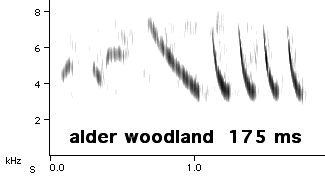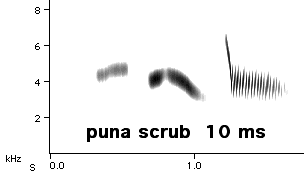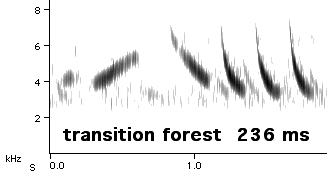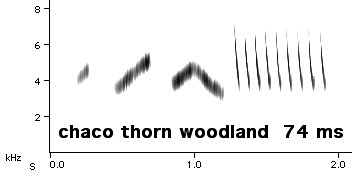
|

|

|

|

|
|
the Rufous-collared sparrow (this is the text of a BOX appearing in: Marler, P. & Slabbekoorn, H. eds. Nature's Music: the science of birdsong. Academic Press (2004). |
| Perhaps one of the clearest and most widely-distributed habitat-related
dialect systems is provided by an ecologically-catholic neotropical songbird,
the Rufous-collared sparrow, Zonotrichia capensis. Extensive
geographic variation in the song of this species became apparent over 30
years ago with Nottebohm's study [9] in subtropical and temperate
Argentina. He interpreted his findings largely in the context
provided by Marler & Tamura [7], that is, he suggested that
these dialects perhaps serve to enhance the genetic integrity of local
populations. The first direct investigation of this possibility [1],
while providing no support for what came to be called the Genetic Adaptation
Hypothesis [GAH; 10], showed that the spatial organisation of song
variation was very closely associated with the distribution of distinct
habitat types. Moreover, the structural characteristics of the dialect
variable (trill interval) showed variation largely consistent with the
interspecific acoustic patterns described by Morton [8], that is,
in general, the trill interval varied from short (~50 msec; rapid trills)
in open grasslands to long (1-200 msec; slow whistles) in woodlands and
forests.
This ecological dimension was explored further by Handford and students in the highly diverse habitats of northwestern Argentina. They showed that the ecological ordering of dialect variation [2,3,4, 6] over a huge geographical space (1200 x 350 km) and across a dramatic sweep of structurally-distinct habitats (puna scrub, grassland, desert scrub, thorn woodland, and drought-deciduous forest (see Figure) was largely consistent with the previously-established picture. This work also demonstrated that these spatial patterns show temporal stability of at least 20 years (now known to exceed 30 years), and stability on the order of centuries is implied by the persistence of certain habitat dialects long after the native vegetation has been removed by agriculture [3]. This massive demonstration of acoustically rational habitat-based song variation strongly supports what is now known as the Acoustic Adaptation Hypothesis [10]. However, the work also provided a basis for a final evaluation of the GAH on a similar geographical scale [5]. This study showed that the substantial genetic variation shown by the species is organised largely by distance; dialect songs impose no further structure: it seems that for this species the GAH has no explanatory value. The most recent work on this species confirms that the clear ecological segregation of acoustically rational vocal dialects in Argentina extends from 22ºS at the Bolivian border south to 42ºS in northern Patagonia. Across this vast space, the greatest song diversity is concentrated in the vegetationally-diverse north west; in the ecologically more uniform central and southern regions, great song uniformity is encountered; finally, island habitats, such as montane grasslands, are represented by repeated islands of the specific song dialect. Other recent work suggests, however, that tropical population (Ecuador) do not show this pattern: instead, individuals show repertoires (from 1-7 trill-types; mean = ~4) and local populations can show nearly as much trill variation as is known from all Argentina. |
| 1. Handford, P. & Nottebohm, F. 1976.
Allozymic and morphological variation in population samples of Rufous-collared
Sparrows, Zonotrichia capensis , in relation to vocal dialects.
Evolution 30: 802-817.
2. Handford, P. 1981 Vegetational correlates of variation in the song of Zonotrichia capensis . Behav. Ecol. Sociobiol. 8: 203-206. 3. Handford, P. 1988 Trill rate dialects in the Rufous-collared Sparrow, Zonotrichia capensis , in north-western Argentina, Can. J. Zool. 66: 2658-2670. 4. Handford, P. & S. C. Lougheed 1991 Variation in duration and frequency characters in the song of the Rufous-collared Sparrow, Zonotrichia capensis, with respect to habitat, trill dialects and body size. Condor. 93: 644-658. 5. Lougheed, S. C. & P. Handford 1992 Vocal dialects and the structure of geographic variation in morphological and allozymic characters in the Rufous-collared Sparrow, Zonotrichia capensis. Evolution 46:1443-1456. 6. Lougheed, S. C. & P. Handford 1993 Covariation of morphological and allozyme frequency characters in populations of the Rufous-collared sparrow, Zonotrichia capensis. The Auk 110(2): 179-188. 7. Marler, P. & M. Tamura 1962. Song "dialects" in three populations of White-crowned sparrows. Condor 64: 368-377. 8. Morton, E. S. 1975. Ecological sources of selection on avian sounds. Am. Nat. 109: 17-34. 9. Nottebohm, F. 1969. The song of the chingolo, Zonotrichia capensis , in Argentina: description and evaluation of a system of dialects. Condor 71: 299-315. 10. Rothstein & Fleischer 1987. Vocal dialects and their possible relation to honest status signalling in the brown-headed cowbird. Condor 89: 1-23. |
Example
sound spectrograms of some habitat-dialect songs

|

|

|

|

|